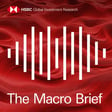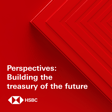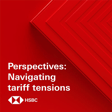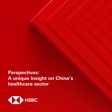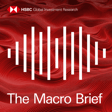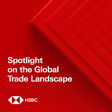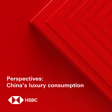Become a Creator today!Start creating today - Share your story with the world!
Start for free
00:00:00
00:00:01

The Macro Viewpoint - EM bulls, Fed hikes, and a global data check
Murat Ulgen looks at why investors are turning more bullish in our latest EM sentiment survey, James Pomeroy assesses the latest global economic data and Ryan Wang explains why further US rate hikes are now likely.
Disclaimer: https://www.research.hsbc.com/R/51/lG9PGsd Stay connected and access free to view reports and videos from HSBC Global Research follow us on LinkedIn https://www.linkedin.com/feed/hashtag/hsbcresearch/ or click here: https://www.gbm.hsbc.com/insights/global-research.
Hosted on Acast. See acast.com/privacy for more information.
Transcript
Introduction to HSBC Global Viewpoint Series
00:00:02
Speaker
Welcome to HSBC Global Viewpoint, the podcast series that brings together business leaders and industry experts to explore the latest global insights, trends, and opportunities.
00:00:13
Speaker
Make sure you're subscribed to stay up to date with new episodes.
00:00:16
Speaker
Thanks for listening.
00:00:17
Speaker
And now onto today's show.
00:00:24
Speaker
The following podcast was recorded for publication on the 9th of March 2023 by HSBC Global Research.
00:00:29
Speaker
All the disclosures and disclaimers associated with it must be viewed on the link attached to your media player.
Emerging Market Sentiment Survey Discussion
00:00:38
Speaker
Hello, I'm Piers Butler.
00:00:40
Speaker
And I'm Peter Stegall.
00:00:41
Speaker
Coming up this week, just how bullish are emerging market investors feeling and why?
00:00:46
Speaker
We assess the results of our latest EM sentiment survey.
00:00:50
Speaker
We look at whether markets are right to be buoyed by improved global economic data so far this year.
00:00:55
Speaker
And we look at what recent hawkish comments by Fed Chair Jerome Powell could mean for the path of US monetary policy.
00:01:05
Speaker
HSBC has just released its latest emerging market sentiment survey.
00:01:09
Speaker
This 11th edition in the series gives an insight into what's on the mind of major investors responsible for over half a trillion dollars of assets under management in emerging markets.
00:01:20
Speaker
We're joined by Dr. Murat Olgun, Global Head of EM Research, who's been analyzing the findings.
00:01:25
Speaker
Murat, welcome.
00:01:27
Speaker
Thank you very much.
00:01:28
Speaker
So Murat, the previous edition of the survey released last December showed investors in emerging markets were starting to feel a bit more optimistic.
00:01:35
Speaker
What's the mood like now?
00:01:37
Speaker
Yes, as a matter of fact, the sentiment has improved even further.
00:01:41
Speaker
So EM investors appear to be unfazed by the recent volatility in financial markets.
00:01:46
Speaker
The share of investors who are now outright bullish on emerging markets has risen sharply to 47% from 29% in the previous December survey.
00:01:55
Speaker
And the share, who is outright bearish,
00:01:57
Speaker
has actually remained almost unchanged.
00:02:00
Speaker
This brings the net of bullish versus bearish sentiment to the highest level since July 2021 survey.
Factors Boosting Emerging Market Sentiment
00:02:06
Speaker
So what's behind this surge in optimism?
00:02:08
Speaker
Well, this survey was conducted over a period when there were renewed worries about sticky inflation, continued tight global monetary policy, and a re-energized U.S. dollar, on the one hand.
00:02:19
Speaker
But on the other hand, smooth reopening of China and generally supportive global economic data.
00:02:25
Speaker
So in a way, we believe we have moved from a pretty adverse global backdrop in 2022 to a rather mixed picture, which is a relative improvement.
00:02:34
Speaker
And investors still attribute a lot of importance to China reopening because 40% sees actually a stronger rebound in China is the biggest upside race to the EM outlook.
00:02:44
Speaker
What has this done for cash levels and risk appetite?
00:02:47
Speaker
Yes, so consistent with that improving sentiment, the cash levels have come down even further.
00:02:52
Speaker
to 5.1% as a share of assets under management from 6.1% earlier.
00:02:57
Speaker
And the risk appetite score has picked up further to 6.9% on a weighted average basis from 6.1% in the previous survey.
00:03:06
Speaker
And that level is actually second highest in survey's history, where zero is no risk in EM and 10 is highest in our gauge.
00:03:13
Speaker
In the last survey, there was a lot of focus on inflation and what central banks might do next.
00:03:18
Speaker
Are investors still concerned about inflation and what else is on their mind?
00:03:21
Speaker
They are.
00:03:22
Speaker
I mean, when we ask about the biggest downside risk to EMR, it's still recession in major economies, even though the probabilities have come down across the regions in the survey and it's still Fed and developed market rate hikes.
00:03:34
Speaker
But as mentioned, this time there's also an upside risk, which is a strong rebound in China.
00:03:39
Speaker
As a matter of fact, when we did a deep dive, half of the investors believed it would be the base metals and the tourism sectors, key beneficiaries from China reopening, followed by energy commodities and consumer products in terms of the spillover from a stronger China economy to the rest of the world, and particularly the emerging markets.
Investor Focus Shift: From Latin America to Asia
00:03:58
Speaker
And so what does all this mean for investors' strategy and regional preferences?
00:04:03
Speaker
Well, investors were most upbeat about Latin America in the previous December survey, and the region has outperformed across all asset classes.
00:04:10
Speaker
Now, they seem to have tramped their bullishness on LATAM in favour of Asia, which is a net sentiment score that is positive all around, but particularly more so for equities and effects.
00:04:21
Speaker
And the positive tone in Asian equities is reflected most in China, Taiwan and India, and this is followed by Brazil and Saudi Arabia elsewhere across Iyam.
00:04:30
Speaker
In terms of the asset classes, there has been renewed optimism on EMFX.
00:04:35
Speaker
Now 67% is expecting EM currency to appreciate over the next three months.
00:04:40
Speaker
This is despite a stronger US dollar recently and is up from 22% in the previous survey.
00:04:45
Speaker
In EM fixed income, there has been a bias for hard currency debt, but now the preference
00:04:51
Speaker
between hard currency and local currency that is a lot more balanced.
00:04:55
Speaker
And on equities, the share of investors looking for EM equities to go higher has actually retraced a bit in the survey, but now there is even a higher share of investors who are looking for emerging market equities to outperform developed market equities.
00:05:09
Speaker
And finally, as an additional question in the survey, a lot of investors see fund flows coming back to emerging markets after significant outflows we've seen, especially from active investors back in 2022.
Rise in ESG Investing and Global Economic Activity
00:05:21
Speaker
And finally, Murat, did the results show any changes to environmental, social and governance investing?
00:05:27
Speaker
Yes, the engagement has picked up.
00:05:29
Speaker
Now, investors who say they're running an ESG portfolio, either directly or indirectly, they're at 38%, up from 29% in the previous December survey.
00:05:39
Speaker
This could be attributed to regulators implementing stronger ESG disclosure and accountability rules, which was also the case last year.
00:05:48
Speaker
Murat, thanks for joining us.
00:05:50
Speaker
Thank you.
00:05:54
Speaker
The latest data suggests global economic activity is picking up.
00:05:58
Speaker
James Pomeroy, global economist, is here to talk us through the figures.
00:06:02
Speaker
James, welcome.
00:06:03
Speaker
Thanks for having me.
00:06:04
Speaker
So James, let's start with the February PMI readings.
00:06:07
Speaker
These are based on surveys of decision makers and private companies and give an idea of how confident they're feeling about the future.
00:06:14
Speaker
So what kind of picture do the PMIs paint?
00:06:17
Speaker
Well, the picture looks considerably better today than it did back in December.
00:06:20
Speaker
We've seen improvements broadly in the PMI numbers across the world in both January and in February, and quite a substantial lift in the numbers, particularly on the services side in February.
00:06:30
Speaker
So things look much brighter today than they did a couple of months ago.
00:06:34
Speaker
Oh, fantastic.
00:06:34
Speaker
So you say services look better.
00:06:36
Speaker
What about manufacturing?
00:06:37
Speaker
So manufacturing numbers are generally a little bit better, but it's more of a case of less bad.
00:06:42
Speaker
So the global manufacturing PMI currently points to no growth at all.
00:06:46
Speaker
But that's a pretty good news story when the previous six or so months had been talking about a big, big slowdown.
00:06:52
Speaker
And we've seen a bit of improvement on the new orders side.
00:06:54
Speaker
So these numbers are picking up.
00:06:56
Speaker
But it is important to stress that's off a very, very low base.
00:06:59
Speaker
So what do you think might be driving this improvement?
00:07:02
Speaker
Is it all about China's reopening?
00:07:04
Speaker
Some of it is, particularly in parts of Asia.
00:07:06
Speaker
So you've had a pickup in China, but the Chinese manufacturing PMI was pretty good.
00:07:10
Speaker
That looks much, much better and has helped to carry along a few of the other Asian economies with it.
00:07:15
Speaker
But broadly across the service sector in particular, we've seen a big pickup in Europe.
00:07:19
Speaker
And that's largely because of much lower gas prices and the impact that that's had on sentiment
Inflation Data and Key Economic Risks
00:07:24
Speaker
too.
00:07:24
Speaker
And we've had a decent set of data in the UK on the services side as well, because households generally feeling
00:07:30
Speaker
a little bit more comfortable with where energy prices are and inflation and businesses seeing the impact of that too.
00:07:36
Speaker
In the US, a similar story as well.
00:07:38
Speaker
But the star globally is India.
00:07:40
Speaker
We had a very, very strong services PMI in India, really the strongest in 12 years.
00:07:47
Speaker
And on the manufacturing side there too, you have the highest readings of anywhere in the world.
00:07:51
Speaker
So India at the moment continues to be the real standout when it comes to PMI data.
00:07:57
Speaker
So thinking globally again, PMIs are painting quite a positive picture, but you've been looking at the broader economic data too.
00:08:04
Speaker
What's happening elsewhere?
00:08:05
Speaker
I mean, what's happening with inflation, for instance?
00:08:07
Speaker
So inflation data at the moment are incredibly confusing.
00:08:10
Speaker
You've had, at the start of this year, January data and February data in the Eurozone, you've had inflation prints that are quite high, continually beating expectations from markets and looking relatively hawkish for central banks.
00:08:24
Speaker
You've had these elevated...
00:08:25
Speaker
inflation prints.
00:08:26
Speaker
But if you look under the surface, the things that really drive the fundamentals of inflation, things like commodity prices, that's energy prices, food prices, you look at shipping rates, you look at all of these sort of input costs that businesses are facing, they all keep improving.
00:08:40
Speaker
So it's sort of two stories in one at the moment, the underlying true input cost inflation is improving.
00:08:47
Speaker
But for now, at least, we're still seeing this relatively elevated output price inflation, consumer price inflation, that's causing central banks plenty of headaches.
00:08:55
Speaker
So it's a complex picture then.
00:08:57
Speaker
What do you see as the key risks from here?
00:08:59
Speaker
There's plenty of risks out there.
00:09:02
Speaker
I think for me, the two that worry me the most is housing markets.
00:09:06
Speaker
In some parts of the world where we're starting to see some of the impact of higher rates.
00:09:10
Speaker
If you look at places like Sweden and New Zealand, you can see that coming through very, very clearly.
00:09:15
Speaker
And I guess there's a risk that you start to see the impact of higher interest rates across the spectrum, be it in the housing market or in other parts of consumer debt.
00:09:24
Speaker
So auto loans, credit card debt, those sorts of things.
00:09:27
Speaker
We're seeing delinquencies picking up a little bit in the US too.
00:09:30
Speaker
So it's that sort of impact of higher rates starting to show in the economy.
00:09:34
Speaker
And the other part of the story is the labour market.
00:09:36
Speaker
If you look at the labour market over the course of the last year or last few years, it's been very, very strong and with key support for consumer spending.
00:09:44
Speaker
But if you start to see people get a little bit more cautious, that could have a quite downward spiral impact on demand and on the broader economy.
00:09:52
Speaker
There's some tentative signs of job openings starting to come down a little bit, confidence in the labour market coming down a little bit.
00:09:58
Speaker
For now, it looks very, very strong, but those numbers are going to be worth keeping an eye on.
00:10:02
Speaker
James, thank you very much.
00:10:04
Speaker
Thank you.
00:10:08
Speaker
I'm Harold van der Linde.
00:10:09
Speaker
And I'm Fred Newman.
00:10:10
Speaker
And you can find us under the banyan tree.
00:10:12
Speaker
Join us weekly where we bring Asian markets and macroeconomics into context with special insight from our regional experts here at HSBC Global Research.
00:10:22
Speaker
Search for HSBC Global Viewpoint on Apple Podcasts or Spotify or join us via the HSBC Global Banking and Markets page on LinkedIn.
00:10:31
Speaker
Enjoy the rest of your podcasts and we'll see you under the banyan tree.
The Fed's Hawkish Stance and Market Expectations
00:10:36
Speaker
We head to the US now where Fed Chair Jerome Powell was more hawkish than many had expected in his semi-annual testimony to the Senate.
00:10:45
Speaker
Let's get the details from Ryan Wang, US economist.
00:10:48
Speaker
He spoke to our managing editor, Aline Van Dyne.
00:10:52
Speaker
Ryan, what accounts for this hawkish shift?
00:10:55
Speaker
Well, it really comes down to three main broad categories of economic news that have come in stronger than anticipated over the past month.
00:11:03
Speaker
And those relate to the labor market, to inflation and to consumer spending.
00:11:09
Speaker
And, you know, these elements are
00:11:11
Speaker
related in some sense because businesses are continuing to see pretty strong demand for their goods and services.
00:11:17
Speaker
That is also leading to strong hiring needs on the part of businesses, which is keeping labor market conditions very tight.
00:11:24
Speaker
And all of these dynamics are also putting some upward pressure on inflation.
00:11:27
Speaker
That's really what we've been seeing over the past month.
00:11:30
Speaker
So a hawkish shift and definitely increased expectations of more 25 basis point rate hikes, but there might even be a 50 basis point hike in March.
00:11:43
Speaker
Just talk us through what you're expecting.
00:11:47
Speaker
That's right.
00:11:48
Speaker
In his recent testimony, Fed Chair Jerome Powell said that if the data continued to surprise the upside, then the committee wouldn't hesitate to go back to faster rate hikes.
00:11:58
Speaker
The type of increases that we saw
00:12:00
Speaker
over the course of 2022.
00:12:01
Speaker
But what he also emphasized is that it will come down to the data, particularly the data over the next couple of weeks.
00:12:08
Speaker
So once again, we'll be looking at these readings on the labor market, on inflation, and on retail spending to judge whether the Fed might consider a 50 basis point rate hike.
00:12:20
Speaker
For now, our forecast is that the Fed will deliver 25 basis point rate hikes at
00:12:25
Speaker
the next three policy meetings in March, May and June, but it will come down to the data.
00:12:31
Speaker
And at the same time, we also know the Fed is carefully evaluating its own rate projections because a new submission will be coming at the March FOMC meeting.
00:12:41
Speaker
And Ryan, why do you think the market expectations in some way were so wrong at the beginning of this year?
00:12:48
Speaker
Has there been a shift in the Fed rhetoric or has the market, has there been some degree of wishful thinking?
00:12:55
Speaker
Well, I think there's been a few different elements.
00:12:57
Speaker
On the inflation side, it is a mixed picture.
00:13:00
Speaker
Around the turn of the year, we saw some signs that inflation pressures had cooled, especially when we talk about goods inflation.
00:13:09
Speaker
And that process is still unfolding.
00:13:11
Speaker
It doesn't mean that inflation has collapsed, but it does mean that certain elements of the inflation process appear to have slowed a bit.
00:13:20
Speaker
That impression was somewhat reversed by the upside surprise to inflation over the past month.
00:13:25
Speaker
Now what's been more consistent and does present a complication for the Federal Reserve is the tightness of the labor market.
00:13:31
Speaker
Here the data have more or less painted the same picture and businesses themselves continue to report the same underlying state when they go out there and look for labor.
00:13:43
Speaker
They continue to cite shortages and difficulties in hiring and most of the data continue to point in that same direction.
00:13:50
Speaker
So once again, it's gonna be important to see if there's any change at all in what the numbers are telling us in the next several weeks.
Conclusion and Podcast Subscription
00:13:56
Speaker
Ryan, certainly a complicated picture.
00:13:58
Speaker
Thanks for the update.
00:14:00
Speaker
Thanks, Aline.
00:14:03
Speaker
So that wraps things up for another week.
00:14:05
Speaker
Special thanks to our guests, Murat Organ, James Pomeroy and Ryan Wang.
00:14:09
Speaker
From all of us here, thanks for listening.
00:14:11
Speaker
We'll be back again next week.
00:14:32
Speaker
Thank you for joining us at HSBC Global Viewpoint.
00:14:36
Speaker
We hope you enjoyed the discussion.
00:14:38
Speaker
Make sure you're subscribed to stay up to date with new episodes.
